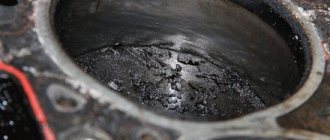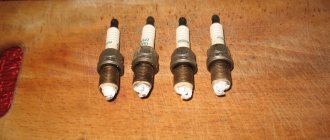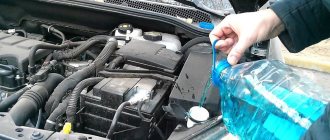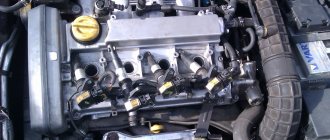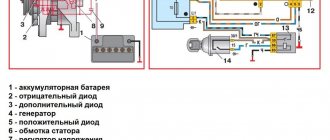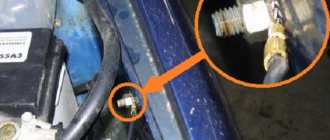Hello, today I’ll tell you what the color of spark plugs means if you unscrew them and examine the electrodes. A twisted candle with its color can explain a lot to those who understand it. By color you can understand the cause of the problem or impending troubles, if you understand what the color of the spark plugs says.
Age and fuel problems
Almost all cars with mileage older than 5 years experience similar problems to one degree or another.
Therefore, it often happens that even after replacing the spark plugs, the ignition quality does not improve or improves only slightly, but the engine continues to fail and start poorly. All “sores” are especially acute during frosts, when the volatility of gasoline is reduced and the fuel mixture ignites much worse, requiring a more powerful spark for ignition than in the warm season. Typical for cars of “venerable age” whose engine life has “crossed the equator” is the penetration of oil from the engine lubrication system into the combustion chamber through the oil seals (valve seals), the cylinder head gasket and oil scraper rings. Burning oil causes the deposit of black-brown oily soot on the spark plugs, which prevents the spark from passing between the electrodes.
And finally, even for new cars, the problem of low-quality fuel turns out to be relevant, which can be refueled even in a city with a million population, not to mention the outback and highways. Of particular danger are additives added to gasoline based on iron and manganese, which cause the spark plugs to become covered with a characteristic brick-colored coating. This reduces the power of the spark and causes breakdowns - improper passage of the spark between the central electrode and the skirt of the threaded part.
Thus, with all the variety of causes and prerequisites, the consequence here is always the same - a lack of high-voltage voltage, which reduces the quality of the spark until it completely disappears.
Practice shows that all processes occurring in the combustion chamber leave a specific imprint on the appearance of the candle. Therefore, its condition can serve as one of the diagnostic parameters to determine how the engine operates.
Causes of white soot
If there is a white coating on the spark plugs, experienced car enthusiasts will immediately identify the problem. This is a lean fuel mixture - relevant for both injection and carburetor engines. But there are other reasons. This is late ignition, as well as incorrectly selected spark plugs for a particular engine. To find the exact cause of such a malfunction, it is necessary to carry out a step-by-step diagnosis of the car.
Frequency of replacement of spark plugs and main causes of plaque
Spark plugs vary in type and destination; in the automotive industry, spark plugs are widely used, the lifespan of which is determined by the type of engine, the type of fuel for the engine and the recommendations of the manufacturer of both the car and the spark plugs. Spark plugs for engines running on reduced natural gas last no more than 10,000 km, while spark plugs for diesel engines should be replaced after 12,000 km, and for gasoline power units after 15-16,000 km, that is, every maintenance.
Soot coloring
During long-term operation, the SZ cannot be perfectly clean, and many people are interested in what the carbon deposits should be like if the car is in good working order, and why this is not always the case. In a situation where the car engine is absolutely in good working order, when you turn out the spark plug, you can see a brownish coating - from light to dark shades of brown. This indicates that the electrode burned out evenly during the operation of the car. If all auto components operate correctly, the service life of ignition elements usually reaches 30,000 km. Modern models of two and three-electrode spark plugs may not need to be changed twice as long. If, upon inspection, the car owner discovers that the spark plugs have carbon deposits of completely different colors, this means that there are obvious irregularities in the operation of the engine. Let's look at the possible types of soot.
White soot
White deposits on spark plugs usually come in several shades, which indicate slightly different problems:
- Grayish tint. This is clear evidence of the use of low-quality fuel. In this case, it is enough to unscrew the SZ and clean it, and they will be ready for further use. An important condition for eliminating the problem will be changing bad gasoline.
- Shiny deposits combined with erosions on the contact electrodes. In this case, you can be firmly sure that the spark plugs are overheating. This situation is often caused by low-quality fuel, incorrectly selected fuel protection, or problems with the cooling system. After eliminating the causes of soot formation, the spark plugs may have to be replaced. In this case, you will need to pay more attention to their thermal characteristics.
- White coating. It should not be confused with carbon deposits. Plaque occurs due to antifreeze entering the engine cylinder. Quite often this process is accompanied by the appearance of white smoke from the exhaust pipe. If you smell the candles, you can feel a pronounced sweetish smell. To eliminate this problem, you will need to eliminate the ingress of antifreeze and only then replace the ignition elements.
Black carbon deposits on spark plugs
As all car enthusiasts note, black soot can be found, perhaps, most often. It may also vary slightly, which indicates breakdowns of various types:
- Velvety black dry soot. Carbon deposits of this type will always be present when using highly enriched fuel and significantly increased gasoline consumption. Such deposits always have the smell of gasoline. If this happened to a car that has a carburetor, then it will be quite simple to adjust the fuel supply system. In the injector version, there may be several reasons why this problem occurred, for example, a problem with the oxygen sensor, a broken throttle valve, or a simple clogged air filter.
- Oily-shiny. Such deposits usually form on the insulator. The car has high oil consumption. Most often, this signals the process of oil entering the combustion chamber. This happens due to severe wear of the valve guides and cylinders, worn oil scraper rings, or due to loss of elasticity of the valve stem seals. This will require the owner of the car to carry out additional diagnostics of the engine and repair the breakdown. Only then should you change the spark plugs.
- Black soot, reminiscent of suede. It appears as a result of an incorrectly selected SV for a given engine. In this case, it will be too “cold” and the self-cleaning process will not occur. Most often this concerns driving around the city at low speed and with frequent stops. After cleaning, the spark plug can be used again, but if driving conditions do not change, you will soon experience the same problems again. The best way out of this situation is to simply choose a suitable candle with a lower heat rating.
Red carbon deposits on spark plugs
If the SZ becomes covered with red soot, and the shade can be completely different, you should first change the station where you most often fill up with gasoline. Such deposits appear only as a result of low-quality fuel. Most often, this problem is observed in cars that fill with 95 or 98 gasoline. Gas station owners, in order to achieve additional profits, add various kinds of cheap additives to 92 gasoline, thereby trying to transfer the fuel to another category. The cheapest additives usually contain various metals, such as lead. During engine operation, metal compounds are deposited on the spark plugs in the form of red soot. This deposit has a high current conductivity, and the spark plug can no longer provide the necessary flash of fuel. In this situation, the car owner will need to not only change the spark plugs, but also be sure to change the permanent refueling location.
Erosion
Quite often, the addition of metal-containing additives to fuel results in erosion at the ends of the electrodes. This is a 100% sign that the spark plugs are no longer suitable for use. Along with replacing the spark plugs, as in the previous case, you will have to change the gas station.
Ash deposit
Sometimes on the ignition elements you can see a coating similar to ash, with completely different shades. In this case, you may suspect a breakdown in the injector or carburetor ignition system. The spark plugs need to be cleaned, if possible, or new ones installed. After a run of 150 km. you need to check the condition of the spark plugs again. If signs of gasoline appear, a trip to a car repair shop to check the carburetor becomes inevitable.
Yellow soot
Sometimes you can see yellowish or even green rims on candles. This is also the result of using low quality fuel, which contains lead. Irreversible consequences for the car in such a situation are not expected in the near future, but it is worth considering whether you need to overpay for such quality gasoline or whether it is worth changing the gas station. Replacing spark plugs in this case is highly desirable.
Carbon deposits on spark plug insulators
Very often, when replacing spark plugs, you can observe dirt on the edges of the spark plug insulator (usually, most often in the form of a white body, in the factory version). This problem has several consequences, and their extent depends on the nature of the resulting deformation. One such example could be gas/combustion product breakthrough. Most often this is the manufacturer’s fault (serial defects, use of cheap raw materials in production).
Cinnamon impurities on the insulator are caused by corona discharge. This process involves ionization of the air surrounding the spark plug, reducing its insulating function when exposed to it for prolonged periods of time. It is worth noting that the nameplate also contributes to the integrity of the insulator itself. In spark plugs with a crack, a gap forms between the insulator and the plug body, due to which the spark plug gradually deteriorates and begins to break through.
By the way, a candle with a brown coating on an insulator does not always signal some kind of violation. Many manufacturers indicate on their product packaging that brown or dark brown colors may result from adhesion of the flammable mixture to the insulator body.
The engine is fine: what should a “healthy” soot look like?
When unscrewing the spark plug from the engine, we compare its appearance with the one it had out of the box. There is no absolute correspondence and there will not be: a used spark plug in any case differs from a completely new analogue. However, there are also similarities.
So, after several hundred kilometers of operation in a working engine, the shade of the insulator should remain the same as it was on a completely new spark plug. This is a white color, which should not change throughout the entire service life of the product. Naturally, the dismantled spark plug must be absolutely dry, without visible residues of oil and, especially, gasoline. As for the condition of the side electrode and skirt, some changes are allowed here.
Stripes on the internal insulator of the spark plug
White stripes on the spark plug insulator on its inner side
This will be caused by a “broken” insulator.
That is, a spark is formed not between the electrodes, but between the central and the body of the spark plug. In this case, the fuel will not burn completely, in some cases, the engine will not start, and even if it starts, it will “triple”.
Misfires will appear, the cylinder, where the spark plug is not working, will not take part in the operation of the engine. Therefore, this mode of the power unit is called “triple”, that is, the operation of only three cylinders instead of four.
The spark does not occur between the electrodes, but between the spark plug body and the central electrode
Causes
- Poor quality candle.
- Perhaps it has not been changed for a long time, it has reached its service life.
- Large carbon deposits on the spark plug.
- Increased gap between electrodes. It is difficult for a spark to “break through” a large distance between the electrodes; it finds the shortest path to the mass and goes along the insulator.
Diagnostics by candles
In fact, there are quite a few ways to determine the presence of a negative impact. A candle is just one of them. For diagnosis, it is best to take a thin wax candle, such as they sell in churches. It is not at all necessary that it be specifically church. You can buy ordinary wax candles at the market or bazaar from those who deal with honey.
True, in some situations, diagnostics may require a large and thick candle, which usually burns for eight hours. Why and why? The thing is that by the time the candle burns you can also diagnose negativity. If a candle burned for six hours or even less instead of the eight prescribed hours, this is clearly a bad sign.
It is also worth remembering that in the absence of negative programs, a lit candle burns quietly and evenly, its flame has a yellow tint (also called lunar), there is no crackling or soot, and the burning time always - we repeat - corresponds to the declared one.
When negativity takes place, all sorts of miracles begin. We will consider them now.
Diagnostics by the color of plaque on spark plug electrodes
A slight light brown (yellow) color of deposits on the electrodes indicates normal operation of the engine and devices integrated with it. But, in some cases, carbon deposits on spark plugs can be black, white or red. It is easy to guess why the spark plugs are black, but determining the true cause of the malfunction is more difficult. Among the main reasons for combustion of the mixture with the formation of excess soot residue:
- violation of the tightness of the gas distribution system (loose fit of valves);
- late ignition (the fuel mixture does not have time to burn completely);
- engine oil entering the combustion chamber;
- excess fuel mixture due to carburetor or injector malfunctions (lack of oxygen);
- air filter clogged.
The main reason for the appearance of black deposits can only be due to inefficient combustion of fuel due to oil getting into it, a decrease in the amount of oxygen, or untimely sparking.
White carbon deposits on spark plugs are formed for other reasons. He is talking about a lean fuel mixture supplied by the carburetor or injectors to the cylinder. We can say that the system does not supply enough fuel or the mixture is oversaturated with oxygen.
In such cases, the car does not start well, but at higher speeds it runs above average. This mode of operation may be liked by fans of fast driving, but it leads to burnout of the cylinders and melting of the metal parts of the spark plugs due to the increased temperature in the combustion chamber.
Red carbon deposits on the spark plugs indicate that you have overused fuel additives that contain metal, or are using gasoline with a higher octane rating by adding additives. The danger of red deposits is that, over time, a conductive layer of iron forms between the electrodes of the spark plug, blocking the formation of a spark and leading to a short circuit in the ignition system.
[custom_ads_shortcode3]
White carbon deposits on the ignition system elements
The gradation of electrode colors from light gray to white (light yellow is also possible) is evidence that the engine is running on a lean mixture. Related reasons may be:
- The product is too hot. The heat rating of the product is lower than that recommended by the manufacturer.
- Large ignition timing angle.
- Using low octane gasoline.
There is no point in delaying in finding out the circumstances that caused this soot-colored condition on the new spark plug. A lean mixture directly causes overheating of both the igniter and the combustion chamber. Ultimately, this situation can lead to burnout of the exhaust valves.
When analyzing the factors that caused a poor quality mixture, it is useful to check for the presence of abnormal glow ignition. A symptom indicating its presence is the reluctance of the engine to stall when the ignition is turned off. In total, this means that the “match” was not created for this engine. This conclusion will not be spontaneous if the heat removal from the igniter is not impaired due to loose tightening of the threaded connection, and there is no dirt under the sealing gasket. If this is the case, then you will have to buy a new kit, after consulting the instruction manual.
Brown deposits on candles
Some car drivers who conscientiously use gasoline choose a “base” for refueling. It's no secret that the first generation of fuels are not “clean” and very often contain many impurities and deposits invisible to the naked eye. However, they affect both the spark plugs and the entire transmission of the car.
Poor fuel quality is quite often the culprit behind additive clogging. In practice, this effect appears as a brown coating on the spark plug insulator. Due to clogging, the car injector cannot cope with its obligations, and gasoline begins to completely flood the spark plug. A standard spark plug electrode is not able to burn all the gasoline surrounding it, and some of it is deposited on the walls of the ignition device itself.
In fact, constant exposure to wet conditions will lead to spark plug failure. The gasoline that was previously deposited on the walls dries out, and the resulting spark exposes the ignition system itself to even greater heat. Brown deposits on the spark plug insulator are a product of recycled gasoline.
Very often, drivers struggling with this problem complain that the engine starts to “spinning”. It is possible that there will be no problems with operation, and the driver will learn about such an event. Only during regular service inspections.
Fuel pollution
The insulator and electrodes of the spark plug are covered with wet black deposits. The candle smells like fuel.
This indicates that at some engine operating modes the power system is preparing a fuel mixture that is too rich. It does not burn completely and produces a large amount of soot. In addition, the cause of this phenomenon may be unstable operation of the ignition system, leading to spark failures, as well as the use of an excessively “cold” spark plug.
The spark plug can be restored. To do this, you need to wash it in gasoline, clean it with a copper brush and dry it. But this will solve the problem only for a while: if you do not find out and eliminate the cause of the malfunction, the spark plug will soon return to its previous appearance.
White deposits
White deposits on the insulator and electrodes of the spark plug
This is a signal of a “lean mixture”.
When a lot of air or little fuel enters the cylinders. There may be more than one reason:
- The oxygen sensor, also known as the lambda probe, is faulty.
- Air leak in the intake manifold after the mass air flow sensor.
- Perhaps an “oil-guzzler” has appeared. There are many additives in oils and some of them do not burn completely.
If, after checking, you are convinced that the air-fuel mixture is not too lean, then you need to check the oil scraper rings. Your engine is getting ready to eat oil. Replacing the spark plugs will not help, but decarbonizing the rings at an early stage can correct the situation.
Injectors and fuel filters
This is a common reason for white spark plugs on injection engines. The needle and nozzle of this element are very thin, however, due to poor quality fuel or a clogged filter, various deposits form on the walls of the injector over time. The diameter of the passage hole, which is already very small, is further reduced. All this provokes a lean mixture.
In this case, the best and most effective solution is to regularly replace fuel filters - both fine and coarse. Cleaning and purging the injectors on special stands can also help.
How to clean spark plugs from carbon deposits
Since stable engine operation depends on the condition and performance of the spark plugs, these elements require care and require timely replacement. As mentioned above, during operation of the power unit, the spark plugs become covered with soot, deposits affect the quality of spark formation and impair the performance of the ignition system.
Taking into account the fact that the service life of spark plugs is limited for a number of natural reasons and strongly depends on the quality of the product, additional accumulation of carbon deposits leads to premature failure of these elements, melting of the electrode occurs, and other defects appear. This can be avoided by cleaning the spark plug from carbon deposits. This cleaning allows you to drive 5-15 thousand km longer with one set.
In order to clean spark plugs with your own hands at home or in the garage, you can use several available methods of mechanical and chemical cleaning.
- The easiest method for cleaning spark plugs is to remove carbon deposits using a wire brush and fine sandpaper. The advantage is simplicity and efficiency. In fact, the car owner manually removes the main contaminants with a brush, after which additional sanding is done with sandpaper. However, this method also has its drawbacks. First of all, after such cleaning, the spark plug insulator becomes covered with scratches, after which carbon deposits are deposited even faster. Also, excessive efforts during cleaning can lead to a violation of the gap between the electrodes, increasing the risk of electrode failure. For this reason, it is not recommended to use metal objects (screwdriver, awl, knife, etc.) to clean electrodes.
- Another method of mechanical cleaning is to remove carbon deposits using sandblasting. This solution is actively used at car service stations. Carbon deposits and deposits are removed using blown sand, after which additional blowing is carried out with compressed air from the compressor. This service has a low cost and allows you to thoroughly clean the spark plugs with minimal damage and scratches, and also saves the car owner’s time.
- In garage conditions, you can clamp the spark plug in the chuck of a reverse electric drill, after which, at speed, the spark plug is lowered into a container with sifted sand. This approach allows you to quickly clean the elements from heavy contamination. In some cases, spark plugs are also cleaned ultrasonically. The principle is similar to cleaning an injector in an ultrasonic bath; it combines the effects of ultrasonic waves and active chemistry. In this case, it should be taken into account that the specific nature of the contamination on the candles does not allow the most effective removal of carbon deposits and deposits using the specified method.
- With that said, many drivers prefer chemical cleaning to the method of physically removing carbon and deposits from spark plugs. In order to clean candles yourself, household chemicals are suitable. Some also use vinegar, heat candles in phosphoric acid or Coca-Cola, use silite, etc. Note that affordable products for removing rust and limescale have proven themselves to be the best. Such compositions are used for cleaning kitchen stoves, tiles, sinks, etc. Let's dwell on this decision. To remove dirt, you need to prepare a rag, a brush or a toothbrush, some water and a container convenient for use (a flat bowl, a shallow pan).
To clean spark plugs with detergent, follow these steps:
- The cleaner is poured into a pre-prepared container. You need to pour in such an amount that the candle is completely immersed in the cleaning composition;
- then the elements are soaked in the cleaner for about 30 minutes;
- after removal, remove any remaining deposits and carbon deposits with a brush or toothbrush;
- the final stage is rinsing in plain water, after which the candles are wiped with a rag as efficiently as possible;
Let us add that an important condition before installing it back into the engine is to dry the spark plugs. This can be done with a household hairdryer or place candles in the oven at a minimum heating temperature for 10-20 minutes, etc. It is not recommended to ignite spark plugs on gas or dry them with a hair dryer. The fact is that significant heating can lead to failure of the spark plug, cracking of the insulator and other defects.
The advantages of this cleaning method include simplicity, absence of mechanical damage, and the effectiveness of cleaning carbon deposits using household chemicals. Deposits are well cleaned from all elements of the spark plug and washed out of hard-to-reach areas. It turns out that such cleaning allows you to remove carbon deposits not only from the electrode, but also to remove deposits from the threaded part and insulator.
A worthy alternative is cleaning candles in a solution of ammonium acetate. For implementation, you will need water, a solution of ammonium acetate in water 20%, gasoline or carburetor cleaning fluid, and a brush with stiff bristles. You should also take into account that the candles will need to be heated in the solution, that is, you need a gas or electric stove.
The sedum itself involves the following actions:
- first, the spark plugs are washed in gasoline or cleaner, which allows them to be degreased;
- Then the elements are dried superficially. After this, the aqueous ammonium acetate solution is heated on the stove to 100 degrees Celsius or so;
Please note that you should not heat such a solution or work with ammonium acetate in closed, unventilated areas, as the vapors can be harmful to the body if inhaled. Before you start cleaning, you need to take special care of ventilation (open the windows, turn on the hood, etc.).
- then the spark plugs should be immersed in the hot solution for 30 minutes. During this time, the temperature of the solution should be maintained; slight boiling is allowed;
- upon completion, the spark plugs are removed, then they are cleaned using a brush;
- after this, the cleaned elements are rinsed in water and dried thoroughly;
Check and repair faulty spark plugs
Timely checking of spark plugs allows you to save yourself a lot of nerves and money costs and give your car the opportunity to demonstrate its full potential on the track. A faulty spark plug must be identified and replaced as quickly as possible. And by the carbon deposits that form on it, you can diagnose the condition of the engine and ignition system.
A typical reason for spark plug failure is incorrect selection of spark plugs when replacing them. All car manufacturers unanimously shout: “Buy only spark plugs recommended for this car.” But sometimes we are hindered by laziness, and sometimes by the lack of opportunity to buy the right candle. And we install on the car whatever comes our way. Moreover, most often we justify our actions by the fact that we do not know how to replace spark plugs correctly. But to do this, you just need to unscrew the spark plugs with a special wrench when the engine is turned off and cold and replace them with new ones.
It is important to remember that new spark plugs must almost perfectly match the thermal and geometric parameters of the standard ones! Otherwise there will be problems. If the heat value (the degree of thermal conductivity of the spark plug) is insufficient, then the driver will face problems with ignition and engine operation
And when the spark plug does not match the geometric size of the threaded part (too short), it will quickly become clogged with carbon deposits and fail.
For those who are not inclined to work with equipment, it is enough to follow a simple rule so that there are no problems with the operation of the engine. You need to change the spark plugs every 50,000 km and clean them every 5,000 km. Those. To ensure that faulty spark plugs do not cause breakdowns, you only need to remove carbon deposits on the spark plugs 10 times (every 2-3 years with frequent driving).
What does plaque on spark plugs indicate?
The gap in the spark plugs is the main sign that the spark plug is not selected correctly.
The light brown color of soot is the ideal “color” of a spark plug. It means that the spark plug is selected correctly, the engine is working properly, and the fuel is suitable for the car.
The white color of the insulator should cause caution, which clearly indicates that the candle is too hot. But the biggest concern should be black spark plugs. Carbon deposits form during long-term operation and overestimation of the heating value. If the engine is new, then soot on the spark plug is formed due to droplets of fuel, and on older engines - oil. Often the cause of soot formation is low-quality and diluted fuel. Since no one in Russia is immune from it, there is no point in getting annoyed, but it makes sense to find out how spark plugs are cleaned.
Carbon deposits on spark plugs - how to get rid of them?
If you drive short distances and relatively infrequently and your mileage does not exceed 10-12 thousand kilometers per year, then cleaning the spark plugs should be carried out only twice - before the start of the winter and summer seasons. If the car experiences heavy loads and is operated in heavy duty mode, the frequency can be increased. To determine it you need to know how to check spark plugs.
If the color of the central electrode skirt is golden brown, minimal carbon deposits, and the complete absence of even a hint of oil, the engine is working perfectly! In all other cases, the candle needs either cleaning or even replacement. If the central electrode and skirt bear the mark of destruction, the spark plug should be replaced, having determined the cause of its destruction (engine, fuel, incorrect selection). In other cases, repairs are possible. Most often, VAZ 2106 engine repair is necessary precisely in cases where the driver has not carried out spark plug maintenance for a long time.
The easiest way to clean candles is with chemicals:
- Remove and degrease the candles
- Dry them well
- Immerse ammonium acetate solution (20%) for 20 minutes
- After this, clean them thoroughly with a stiff brush.
However, don't get carried away! And use more powerful products instead of a brush (knives, awls, blades). Of course, it’s easier to remove plaque with their help. It’s just easy to leave severe scratches on the insulator. Which will subsequently cause even faster formation of soot. If you don’t have a brush, you can wrap the knife in a cloth. And only after that clean the candle.
Instead of ammonium acetate solution, you can use a regular rust converter. It is poured into a small container and the candle is placed so that the liquid covers only the thread and the lower part of the candle. Leave for half an hour and then clean with a brush.
How can you check spark plugs?
Agree that most of us check spark plugs when the first causes of their problems occur. Naturally, this is not the right move for an owner monitoring the operation of his vehicle.
Check the condition of the spark plugs every 5-8 kilometers.
How to eliminate white plaque?
Cleaning spark plugs
One of the most popular methods for eliminating white residue on spark plugs is manual cleaning. But please note that at home, the risk of damaging the insulating coating of the motor is very high. It is worth adding that on damaged insulators, a white coating settles more often than on intact and undamaged ones. Also, do not clean candles with hard or sharp materials. Special brushes or tapes with long and thin connecting wires are best suited.
Spark Plug Maintenance
If you have driven more than 30-40,000 kilometers on the same spark plugs, then even with a working ignition system, they will begin to act up. Plaque and iron oxide form on the electrodes, preventing the formation of a spark. In addition, when the metal burns out, it increases the distance between the electrodes, which complicates sparking.
Typically, spark plugs are replaced after long-term use, but in some cases their service life can be extended. To do this, just clean the contacts. But if you just clean the carbon deposits, the effect may be negative due to an increase in the gap between the electrodes.
You can restore the nominal gap by bending the upper electrode of the spark plug, monitoring it using a special probe.
Probe for measuring gaps You should also pay attention to the condition of the insulators. If the insulator has cracks or other mechanical damage, the spark plug must be replaced. The presence of oil and dirt on the insulator is unacceptable. This reduces the effectiveness of the insulator, reducing resistance to electrical current. Its surface must be cleaned.
If the surface of the insulator is covered with an oil coating, then it is possible that the spark plugs are not screwed in tightly. They need to be unscrewed, the seats, contacts, insulators must be cleaned and screwed in again using a torque wrench. Table 1 shows torque values depending on the type of spark plugs and head material.
| Flat Fit Spark Plug (with Seal) | Tapered Fit Spark Plug | |||||
| Cylinder head material | Thread diameter | Thread diameter | ||||
| 18 mm | 14 mm | 12 mm | 10 mm | 18 mm | 14 mm | |
| Cast iron head | 35-45 Nm | 25-35 Nm | 15-25 Nm | 10-15 Nm | 20-30 Nm | 15-25 Nm |
| Aluminum head | 35-40 Nm | 25-30 Nm | 15-20 Nm | 10-12 Nm | 20-30 Nm | 10-20 Nm |
[custom_ads_shortcode1]
Cleaning the ignition elements
Spark plugs do not always require immediate replacement; sometimes they can simply be cleaned and the possible cause of deposits can be eliminated. This procedure can be carried out in two ways:
- Mechanical cleaning method. It consists of using simple sandpaper or a small wire brush. Despite the simplicity of the method, it has a number of disadvantages. With such cleaning, the coating on the SZ electrodes can be damaged, and simple scratches can cause increased accumulation of deposits.
- Chemical method. It is more preferable, especially for removing black deposits. The car enthusiast will need to prepare simple cleaning products, a toothbrush and a rag. The elements need to be soaked for about half an hour and then rinsed well. After drying, the candles can be used again.
Ash and erosion
Ash deposits are also a consequence of lubricant ingress. But the amount of lubricant that has penetrated into the cylinders is not yet very large, so it burns, releasing a large amount of wear products that settle on the electrodes in the form of ash.
Erosion on spark plug electrodes (clearly visible defects and traces of melting) occurs in two cases:
- The first is the exhaustion of the life of the spark plugs, which causes interruptions in their operation and deterioration in spark formation. If you continue to operate the car on such spark plugs, then due to interruptions the combustion process changes, which is the cause of melting.
- The second case is the presence of tetraethyl lead in gasoline. This additive affects the combustion process and, as a result, the spark plugs. In this case, it is enough to replace the fuel and spark plugs.
Traces of technical fluids on spark plugs
Traces of gasoline are the result of a non-functioning or intermittently functioning spark plug. In this case, a spark does not occur in the cylinder and the fuel simply does not burn, but flies out into the pipe, and also settles on the elements installed in the combustion chamber, including the spark plug.
Strongly visible traces of oil on the electrodes of the spark plugs are the result of excessive amounts of lubricant entering the combustion chambers. This happens in case of severe wear of the cylinder-piston group or oil seals and valve guides. Because of this, oil penetrates into the combustion chamber in unacceptable quantities.
Glazing
The surface of the spark plug insulator is glossy, yellowish in color. Those who like to press hard on the gas have the greatest chance of seeing such a spark plug on the engine of their own car. The formation of glaze on the insulator occurs due to a rapid increase in temperature in the combustion chamber at the moment of sharp pressing of the gas pedal. When heated, ordinary deposits on the surface of the insulator melt, forming an electrically conductive glassy coating. As a result, sparking failures occur, especially at high engine speeds. The spark plug cannot be restored; it must be replaced.
